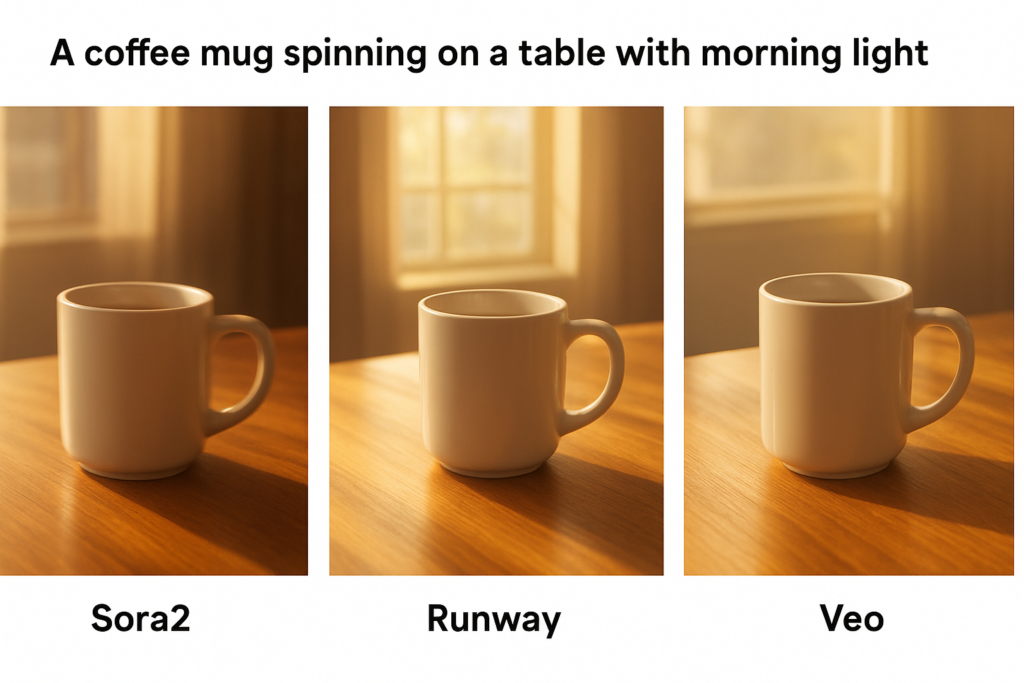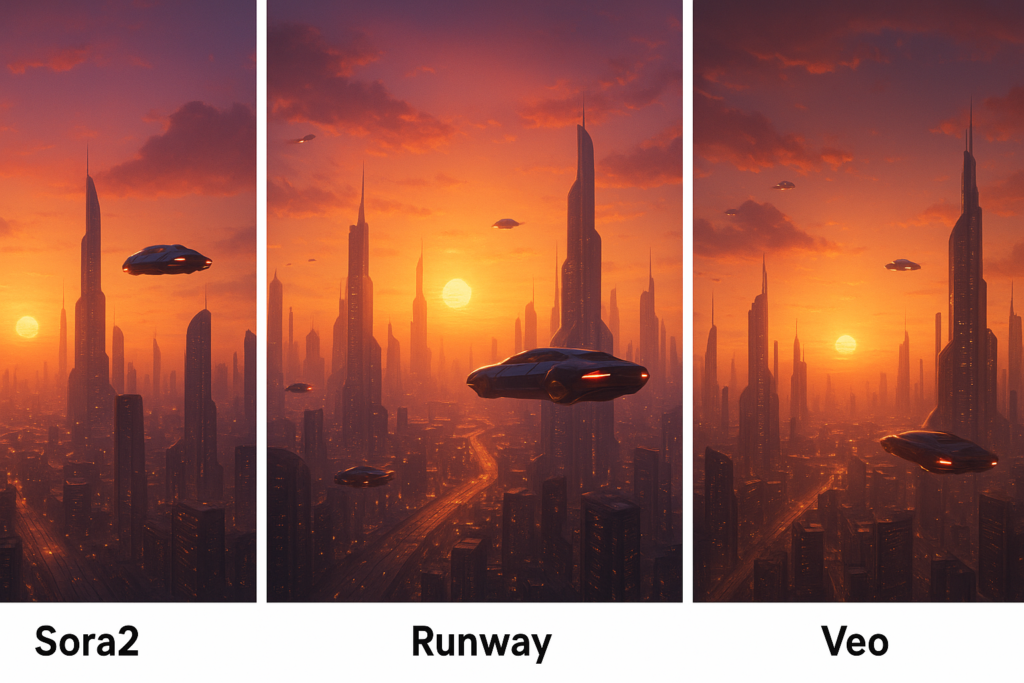Getting good results from Sora 2 (or any text-to-video model) is as much art as science. Below are patterns, tactics, and things to avoid that tend to improve output fidelity, coherence, and visual quality from Sora 2.
Sora 2 Prompting Tips
1. Be Specific & Detailed
- Describe exactly what you want: subject(s), actions, setting, mood, time of day. Vague prompts often lead to confusing or generic output.
- Use adjectives: colors, textures, lighting, atmosphere. E.g. “soft golden light,” “misty forest,” “cinematic depth of field.”
- Specify camera/shot details (angle, movement, focal length) — e.g. “wide angle,” “dolly in,” “over the shoulder shot.”
2. Use a Story or Temporal Structure
- Think in terms of a beginning → middle → end, or key moments you want to capture. This helps the model know how to transition frames.
- You can use a storyboard style prompt: “At 0 s: the hero steps forward; at 3 s: camera pans left; at 6 s: reveal the city behind her.”
- If the scene is complex, break it into multiple prompts/videos and stitch them or remix. Sora 2 sometimes struggles with too many simultaneous actions.
3. Define Style, Mood & Visual Tone
- Use words like “cinematic,” “surreal,” “photo-realistic,” “soft focus,” “moody,” “dreamlike,” “film noir” to guide the aesthetic.
- You can reference visual inspirations: “in the style of Blade Runner,” “like a Wes Anderson scene,” or “animation style like Studio Ghibli.” But such references sometimes backfire if the model misinterprets. Use with caution.
- Give lighting guidance: “golden hour sunlight,” “backlit silhouette,” “neon glow,” “harsh shadows,” etc.
4. Movement & Dynamics Matter in Sora 2
- Use verbs and motion descriptors: “walks,” “runs,” “flies,” “drifts,” “rotates,” “swings,” “camera dollies in,” “steadicam shot,” etc.
- Indicate relative speed or tempo: “slow motion,” “fast pan,” “zoom out quickly.”
- Be cautious with too many simultaneous motions (many moving characters + camera moves) — the model can get confused or produce artifacts.
5. Control Composition & Framing
- Specify foreground, midground, background elements. E.g. “In the foreground, a child; midground, a path; in the distance, mountains.”
- Guide focal points & depth: “shallow depth of field focusing on the character’s face, background softly blurred.”
- Indicate whether you want static or moving camera. Sometimes “fixed camera” vs “tracking shot” clarifies.
6. Iterate, Remix, Refine
- Rarely does a prompt succeed perfectly on the first try. Evaluate the output, note what’s off (artifact, missing detail, weird motion), and refine.
- Use “keep” or “remix” operations (if Sora 2 supports them) to salvage parts you like and discard others.
- Slight rewording can produce big differences. Try alternate phrasing of the same idea.
7. Don’t Overload Sora 2 With Instructions
- Too many instructions in one prompt can confuse the model. A prompt overloaded with 8–10 adjectives + multiple camera moves + several characters + lighting + special effects might fragment.
- Prioritize the most important elements. If something is secondary, skip or imply it.
8. Watch for Artifacts & Quality Issues
- Sora-generated videos may show boundary defects, texture noise, movement anomalies, object mismatches/disappearances in some frames.
- Avoid ambiguous prompts that force the model to “guess” context — that’s where artifacts creep in.
- Sometimes post-processing or manual touchups may be needed, especially for small inconsistencies.
9. Respect Content & Safety Constraints
- Avoid prompt content that violates content policies (violence, hate, disallowed use). Models usually enforce filters.
- Because Sora 2 uses a watermark to signal AI-generated content by default, be aware that outputs carry that watermark.
- Also be mindful of likeness, copyrighted characters, and derivative risk.
Example Prompt Templates for Sora 2
Here are a few stylized templates you can adapt:
Template A (Cinematic Scene):
“A lone swordswoman walks down a misty forest path at dawn, soft amber light filtering through ancient trees. The camera pans from her boots upward to her face, following her determined gaze. In the background, fog rolls over mossy stones. Cinematic, moody, shallow depth of field, 35 mm lens.”
Template B (Fantasy / Magic):
“A young mage conjures a glowing blue orb in a gothic cathedral. Sparks swirl, candles flicker, stone pillars cast long shadows behind her. The camera does a slow dolly-in from left to right. Dramatic, high contrast, mystical atmosphere.”
Template C (Action / Motion):
“A futuristic hovercar speeds through neon-lit city streets at night. Rain slicks the roads; reflections bounce off windows. Camera tracks beside the car, then cuts to overhead drone shot. Energetic, sleek, cinematic color grading.”
Template D (Product / Showcase):
“A modern smartwatch hovers in midair above a white pedestal. It spins slowly, displaying different screens. Soft studio lighting, clean minimal background, close-up macro shot, subtle motion blur.”
Comparison: Sora 2 vs Rivals (Runway, Veo, Kling, etc.)
Let’s compare strengths, weaknesses, and use-case fit among major AI video tools.
Overview of Rivals
- Runway — has a suite of generative video models (Gen-1, Gen-2, Gen-3, Gen-4) with features like image references, style transfer, consistent characters across frames.
- Veo / Veo 3 — Google / research tool; one of the known text-to-video models in development.
- Kling, Luma, Pika, etc. — newer models focusing on motion control, longer durations, high resolution, or modular pipelines.

Verdict (as of now): Sora2 is a leading option if your core goal is high-quality short videos with strong visuals, minimal fuss, and you’re comfortable with prompt engineering. Runway is more versatile, especially if you need interactive editing, references, longer consistency, or a hybrid workflow (human + AI). Veo and other models are exciting but still catching up in stability and production-readiness.
One user insight:
“Runway is way ahead of Sora when it comes to generating outputs with shorter and crisper prompts. In fact, it’s pretty fast compared to Sora too.”

But others caution that Sora sometimes ignores parts of prompts or adds unintended elements — the randomness factor remains.
Also, in evaluations, some found that Runway produced disjointed limbs or odd artifacts in human body parts, while Sora maintained better architectural or scenic fidelity in certain contexts.
What to Choose Depending on Your Needs
- social / marketing clips, quick ideation, transforming text to video fast → Sora 2 is excellent.
- Reference-based consistency (e.g., same character, outfit across scenes) → Runway (especially with Gen-4) may give you more control.
- Experimental or avant-garde styles, motion-driven content → Explore Kling, Pika, or other niche models.
- If you need integration with editing pipelines or tools → A tool with robust APIs and export flexibility (often Runway) is advantageous.




